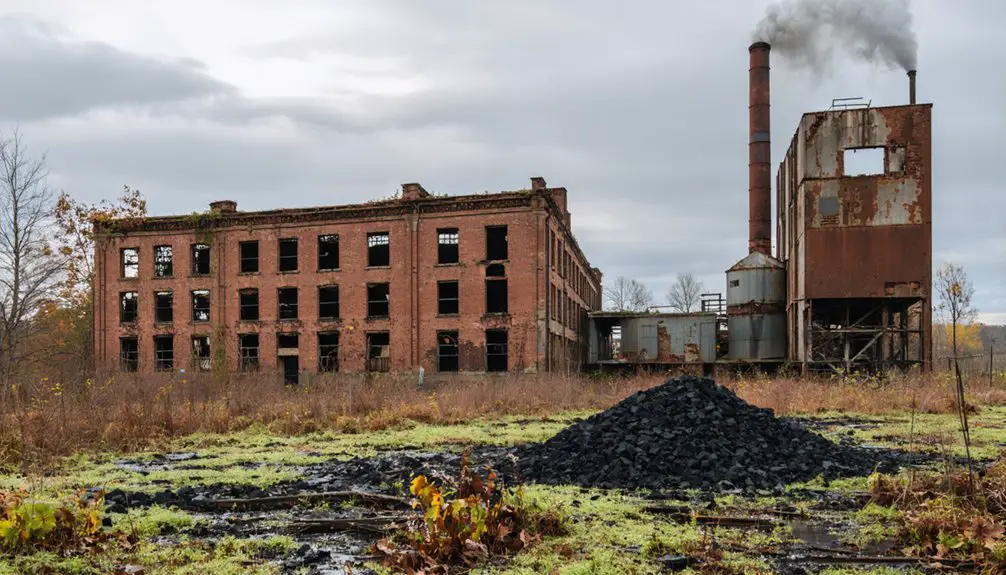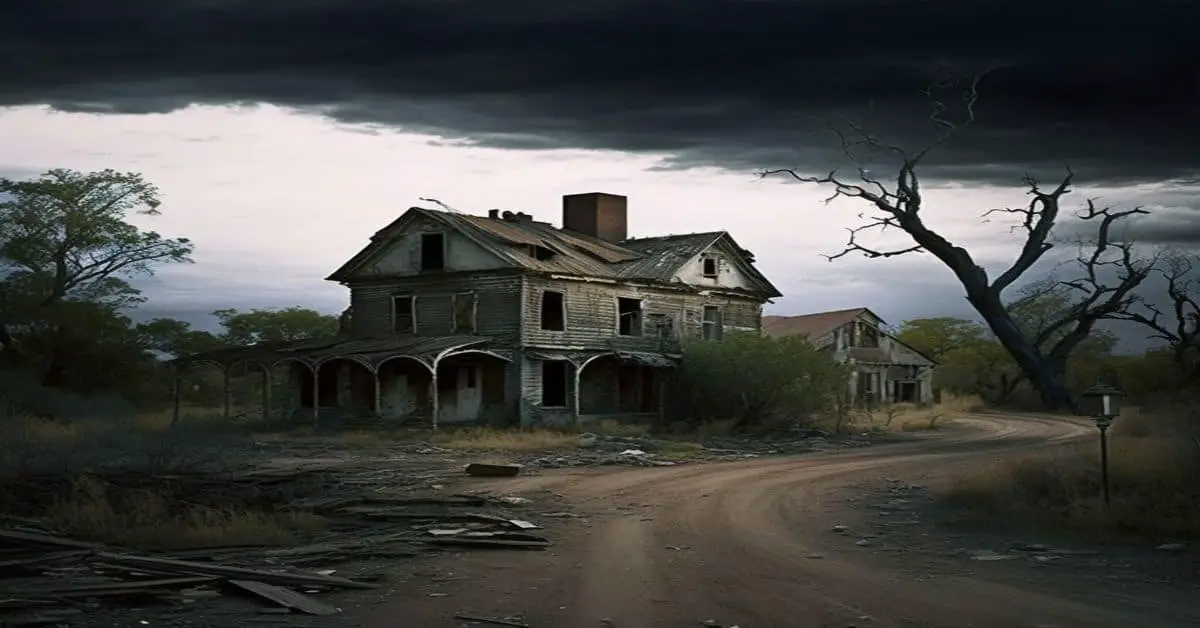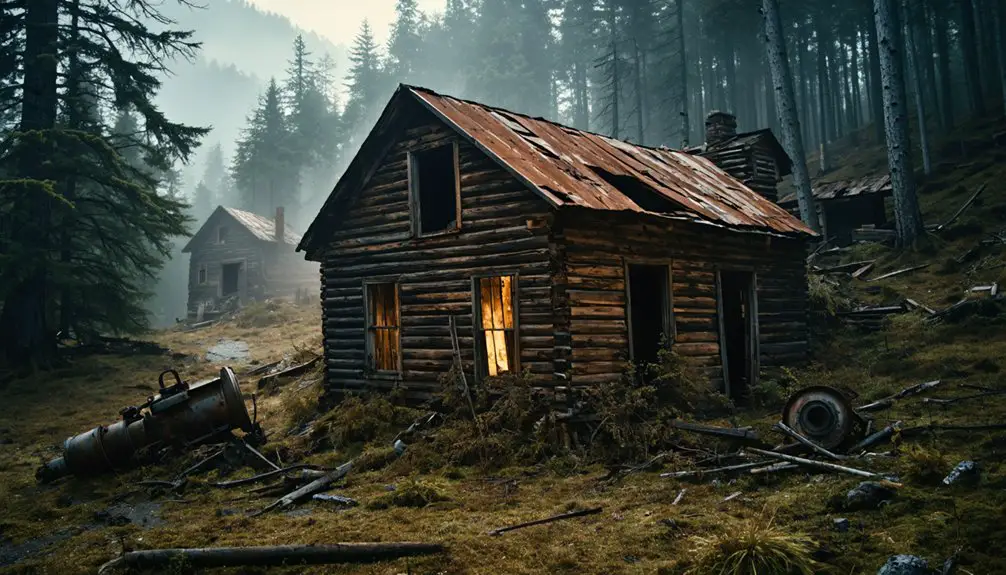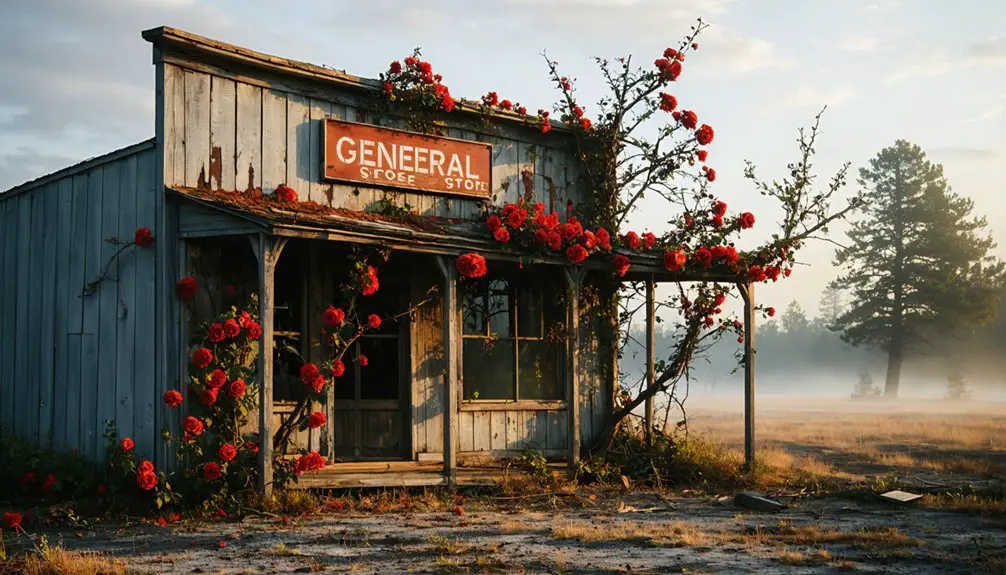You’ll find the abandoned remnants of Thomas, Maryland, along the Patapsco River, where textile production began in 1810 with Thomas Ely’s mill. The town, later renamed Alberton, thrived through industrial growth until the 1960s when only 90 families remained. Today, crumbling foundations, weathered structures, and old railroad bridges dot the landscape. Local storytellers and historians preserve countless tales of this once-bustling company town‘s rise and fall.
Key Takeaways
- Thomas was a thriving industrial town in Maryland that became a ghost town after the decline of coal mining operations.
- The Davis Coal and Coke Company controlled the town’s economy, producing 4,000 tons of coal daily by 1906.
- By the late 1960s, only 90 families remained as housing conditions deteriorated following industrial decline.
- The town contains scattered ruins of industrial infrastructure, including crumbling foundations, weathered structures, and abandoned railroad bridges.
- Originally known as Elysville, then Alberton, Thomas’s transformation into a ghost town began with mill closures and housing abandonment.
The Birth of a Company Town
As the West Virginia Central & Pittsburgh Railway pushed into the Allegheny Mountains in 1884, it set the stage for Thomas, Maryland’s transformation from wilderness to thriving industrial hub.
Jacob C. Pase, the first documented settler, arrived in 1880 and witnessed the area’s dramatic evolution into an industrial powerhouse.
You’d find the Davis Coal and Coke Company quickly establishing its dominance, taking control of 100,000 acres and producing 4,000 tons of coal daily from Thomas’s mines alone. Workers earned roughly $75,000 per month on the company payroll by 1906.
The company’s grip extended beyond mere ownership of land. They built Coketon, a companion town right next to Thomas, where they controlled every aspect of workers’ lives through company housing, stores, and schools.
Like feudal lords of old, the Davis Coal and Coke Company crafted an empire where workers lived and breathed under corporate rule.
Labor dynamics were complex, with the company wielding power through mandatory store purchases and using African American workers as strikebreakers during disputes.
Industrial Roots and Early Development
While Thomas emerged as a coal-driven boomtown in the late 1800s, its industrial roots stretch back much further.
You’ll find its industrial heritage began in 1810 when Thomas Ely established a textile mill along the Patapsco River, creating a settlement originally known as Elysville.
The town’s textile manufacturing focus centered on cotton production, with a main mill building completed in 1846 becoming the architectural cornerstone of the community.
In 1853, after James S. Gary purchased the bankrupt operation, the town was renamed Alberton in honor of his son. The Oskiska Manufacturing Company produced cotton textiles in the mill building.
The Great Depression severely impacted operations, with the mill employing only about 35 workers during this difficult period.
The Alberton Manufacturing Company expanded operations, doubling its output.
A critical railroad connection from the 1830s linked the growing industrial center to regional markets, setting the foundation for decades of prosperity.
Life in Thomas During the Peak Years
If you’d lived in Thomas during its peak mining years, you’d have found a close-knit community centered around the company-built homes, where families tended front yard gardens and gathered regularly at the opera house.
Like many abandoned communities that became ghost towns later, residents eventually relocated with only their memories of this once-thriving place. Your daily life would’ve revolved around the mining schedule, with social activities taking place at the opera house’s bowling alley, dance floor, and community meeting spaces. Workers often received chinky tink scrip as payment advances for use at the store.
The company store served as both a retail hub and social anchor, where miners’ families crossed paths while purchasing supplies and exchanging news about community events.
Daily Community Activities
During Thomas’s peak years, the town buzzed with activity centered around its company stores and social establishments.
You’d find residents gathering at the general store, not just to purchase supplies on credit but to exchange news and maintain community interactions.
The town offered diverse leisure activities – from bowling alleys and pool halls to baseball games on the local field.
The mill’s post office served as another key gathering spot where residents would collect their mail and catch up on local happenings.
You could spend evenings at the opera house or join community dances that brought together families from various ethnic backgrounds.
Churches served as essential social hubs, hosting celebrations and holiday gatherings that strengthened community bonds.
The local school doubled as a meeting place for evening events, while the company store’s lunchroom provided a spot where you’d catch up with neighbors during meal breaks.
Working Class Social Life
As Thomas reached its industrial peak, you’d find a vibrant working-class community shaped by diverse immigrant groups including German, British, Polish, Hungarian, Austrian, and Swedish laborers.
Churches served as essential social hubs where you could gather with neighbors, reinforcing cultural bonds and providing spiritual comfort amid challenging industrial conditions. The community spirit was further strengthened by Saint Stanislaus Kostka Church which stood as a testament to local resilience.
The social dynamics often reflected workplace hierarchies, with African-American workers facing both occupational segregation and heightened risks in dangerous furnace operations. The Maryland Iron Company employed hundreds of workers in its peak years, creating a bustling industrial community.
Yet labor solidarity emerged through shared experiences in company housing and collective responses to workplace grievances.
You’d witness community events organized along ethnic lines, while local stores and schools became natural meeting points where workers’ families forged connections despite company control over most aspects of daily life.
The Economic Engine Behind Thomas
While many American towns emerged from diverse economic foundations, Thomas, Maryland thrived solely on the power of coal mining. You’d find the Davis Coal & Coke Company at the heart of this economic dependency, operating essential sites like Mine Forty-two that kept the town alive.
The corporate influence extended beyond just employment – they controlled housing, infrastructure, and daily life. Much like the wealthy colonial gentry class who controlled tobacco plantations, the company maintained a tight grip on the local economy. You couldn’t escape the company’s reach even in death, as their scrip currency system locked workers into a cycle of financial dependence.
The B&O Railroad and C&O Canal served as lifelines, shipping coal to regional markets. When mid-20th century energy markets shifted and Davis Coal & Coke shuttered operations, Thomas’s fate was sealed.
Without economic diversification to fall back on, the town’s collapse was swift and absolute.
Social Fabric and Community Bonds

In the mill town of Thomas, you’d find the heart of community life centered around key gathering spots like St. Stanislaus Kostka Catholic Church and the Pentecostal Holiness Church, where residents came together for both worship and social events.
The Gary family’s paternalistic management extended to providing essential social spaces including company stores, housing, and entertainment venues that fostered daily interactions among workers and their families.
These communal bonds were strengthened through shared labor experiences and mutual support networks, creating a tightly knit social fabric that would eventually unravel with the mill’s closure in the late 1960s.
Community Gathering Places
During its heyday, Thomas’s social fabric centered around key gathering places that formed the heart of community life.
You’d find the company store strategically positioned near the town’s border, serving as both a commercial hub and social venue where residents regularly crossed paths.
The opera house became a vibrant multipurpose space featuring a lunchroom, bowling alley, pool tables, and dance floor where you could unwind after work.
Churches and the local school building doubled as community centers, fostering deep connections among families.
Post offices merged with social spaces to encourage regular community interactions.
Even the planned layout of residential areas, with their front yards and shared gardens, created natural gathering spots where neighbors could socialize and strengthen their daily bonds.
Neighborhood Support Networks
As Thomas developed around its textile mills, the town’s social fabric grew remarkably strong through interconnected networks of mutual support. The shared economic dependence on textile manufacturing created tight bonds among residents who looked after each other’s interests and well-being.
- Neighbors freely exchanged resources, skills, and labor during the mills’ operation.
- Informal childcare networks formed naturally through extended family connections.
- Community rituals and local events reinforced social bonds.
- Churches and workplaces served as hubs for organizing mutual assistance.
This support system thrived until company decisions to close housing and industrial decline forced relocations in the late 1960s. The displacement scattered long-standing neighborhood networks, though some connections survive today through heritage groups and descendants who maintain ties through genealogical research.
The Beginning of the End
While Thomas Ely’s family had established the town as Elysville in 1810, the community’s steady decline began with ownership changes that foreshadowed its eventual demise.
You can trace the decline dynamics through multiple shifts: from Elysville to Alberton in 1853 under the Gary family, then to Daniels in 1940 when C.R. Daniels Company purchased it for $65,000.
Despite the community’s resilience through these changes, the real turning point came in 1968 when C.R. Daniels Company announced the closure of all town housing.
By the late 1960s, only 90 families remained as housing conditions deteriorated rapidly.
The Saint Stanislaus Kostka Catholic Church’s destruction by lightning in 1926 had been an early warning sign of the town’s impending fate.
Remnants of a Lost Era
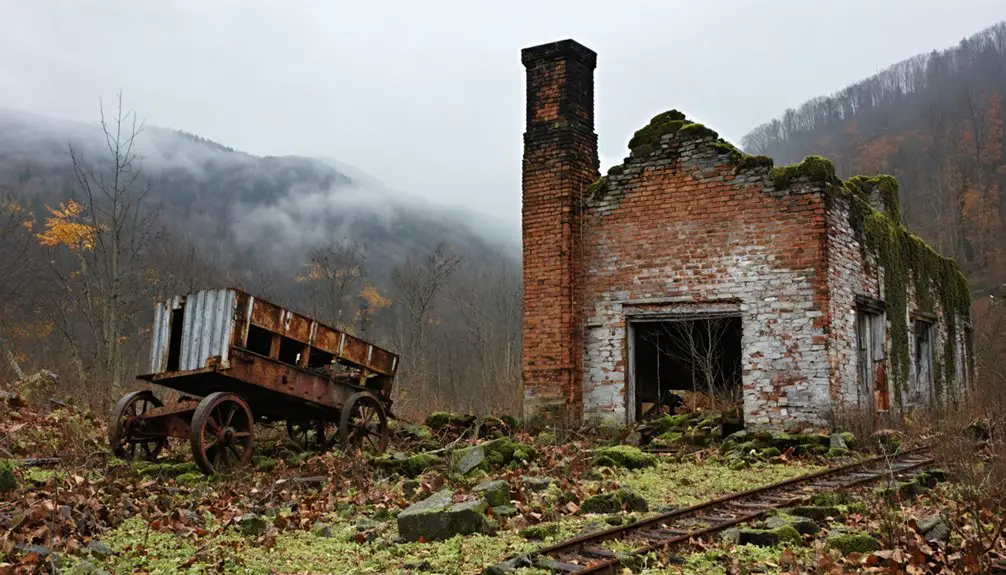
Today’s visitors to Thomas will find a haunting collection of ruins scattered across the once-thriving industrial town. The architectural decay reveals itself through crumbling foundations, weathered retaining walls, and roofless structures reclaimed by nature.
Decaying remnants of industry haunt Thomas’s landscape, where nature slowly reclaims abandoned foundations and weathered walls of a forgotten era.
You’ll discover remnants of a bygone era where cultural symbolism meets wilderness, as modern graffiti adorns the fragments of this abandoned community.
- Navigate remaining staircases and pathways to glimpse deteriorating mill foundations
- Explore the grounds of still-active Gary Memorial Church amid the surrounding desolation
- Find mysterious drawings and symbols added by modern visitors to historic structures
- Follow old railroad bridges and waterways to locate hidden industrial ruins
The site’s privately owned status means you’ll need to tread carefully, but these fragments tell powerful stories of Thomas’s industrial past.
Legacy in Local Memory
Though Thomas’s physical structures have largely crumbled away, the town’s spirit lives on through a rich tapestry of local storytelling and cultural memory.
You’ll find descendants gathering at historical society meetings to share oral histories about daily life, working conditions, and social practices from the town’s heyday. Their memory preservation efforts have helped document everything from ghost sightings to the devastating impact of natural disasters like Tropical Storm Agnes.
Despite limited physical remains and archival records, you can discover Thomas’s legacy through the Smithsonian’s research and local museums’ dedication to regional heritage.
The town’s story continues to captivate audiences through educational programs and heritage tourism, connecting you to broader themes of Appalachian mining culture and Maryland’s industrial past.
Geographic and Historical Context

Nestled along the Patapsco River between Baltimore and Howard counties, Thomas emerged as an industrial settlement that would experience multiple identity changes throughout its history.
Perched between two Maryland counties, Thomas evolved from its riverside roots into a town of shifting identities and industrial heritage.
The town’s dramatic geographic features included limestone outcrops and towering 90-foot cliffs dropping to the river’s edge, creating a rugged landscape that would shape its industrial destiny.
Key aspects of Thomas’s historical significance include:
- Originally established as Elysville in 1810 when the Ely family built their textile mill.
- Renamed to Alberton in 1853 under the Gary family’s ownership.
- Became known as Daniels in 1940 when the Daniels Company took control.
- Located near the historic Warrior’s Path, an important colonial trade route connecting Maryland to Virginia and Pennsylvania.
Preserving Thomas’s Story
Through coordinated efforts between the Maryland Historical Trust and local preservation groups, Thomas’s rich industrial heritage continues to be documented and protected for future generations.
You’ll find preservation initiatives that include detailed architectural studies, archaeological excavations, and thorough documentation of remaining structures and artifacts.
Community engagement plays a crucial role in keeping Thomas’s story alive. You can participate in public archaeology events and guided tours that connect you directly with the site’s history.
Local developers and preservation agencies have partnered to create interpretive displays that tell Thomas’s story, while MHT’s grant programs and tax credits help fund ongoing conservation work.
The site’s preservation guarantees you’ll experience an authentic glimpse into Maryland’s industrial past, with stabilized structures and cleared pathways making the historic landscape accessible.
Frequently Asked Questions
Were There Any Major Accidents or Disasters in Thomas’s Mining Operations?
You’ll find two devastating mining accidents in Thomas’s operations: the 1916 Davis No. 42 Mine explosion killed 16 miners, while the 1907 Thomas No. 25 disaster claimed 25 miners’ lives.
What Happened to the Residents’ Personal Belongings During the Town’s Abandonment?
You’d think those ghostly artifacts and forgotten treasures made it out safely, but they’re lost forever – demolished with homes, washed away by Agnes in ’72, or abandoned during the company’s forced evacuation.
Did Any Famous People or Notable Historical Figures Visit Thomas?
You won’t find records of any famous visitors or notable historical figures in Thomas. While the town held local historical significance, there’s no documentation of celebrated personalities ever stopping there.
What Was the Average Wage for Workers in Thomas’s Industrial Facilities?
You’d find industrial workforce wages were paid per ton of coal mined rather than fixed salaries, with miners seeking a 10-cent per ton increase during 1885 wage negotiations in the region.
Were There Any Documented Paranormal Activities in Thomas After Its Abandonment?
Like a blank canvas untouched by spirits, you won’t find documented paranormal activity in Thomas. Despite Maryland’s rich haunted history, there aren’t any verified ghost sightings or urban legends from this abandoned town.
References
- https://vitabrevis.americanancestors.org/2020/12/ghost-towns
- https://www.youtube.com/watch?v=sbFq0i5w0-c
- http://allenbrowne.blogspot.com/2012/03/upper-potomac-ghost-town-in-southwest.html
- https://en.wikipedia.org/wiki/List_of_ghost_towns_in_Maryland
- https://kids.kiddle.co/List_of_ghost_towns_in_Maryland
- https://theclio.com/entry/36357
- https://parsonsadvocate.com/news/pa-top-stories/headlines/a-brief-history-of-the-thomas-west-virginia-area/
- https://historicthomaswv.org/coal-industry
- https://www.nps.gov/articles/thomas-cresap-and-maryland-s-colonial-frontier.htm
- https://en.wikipedia.org/wiki/Thomas_Cresap
